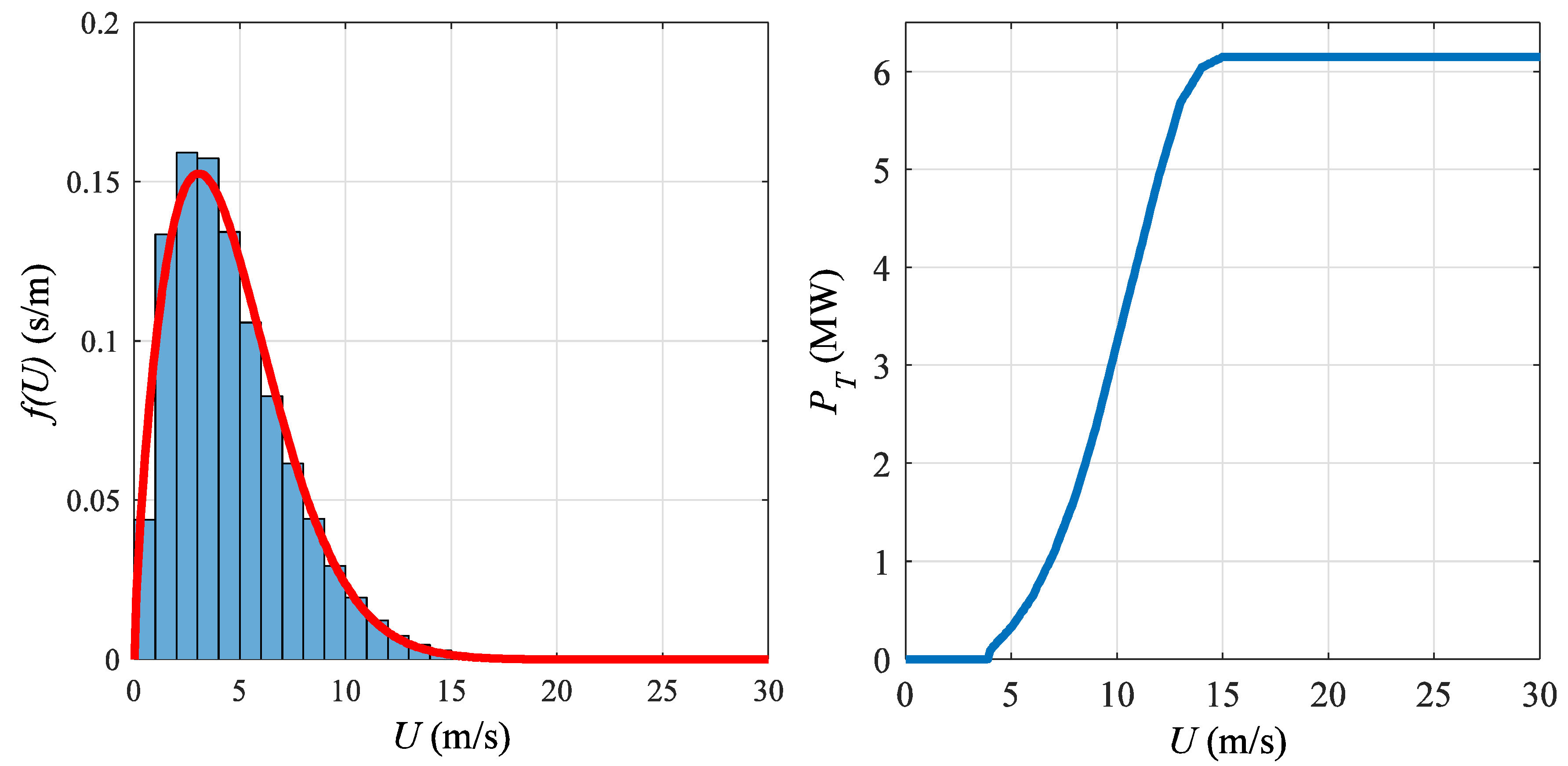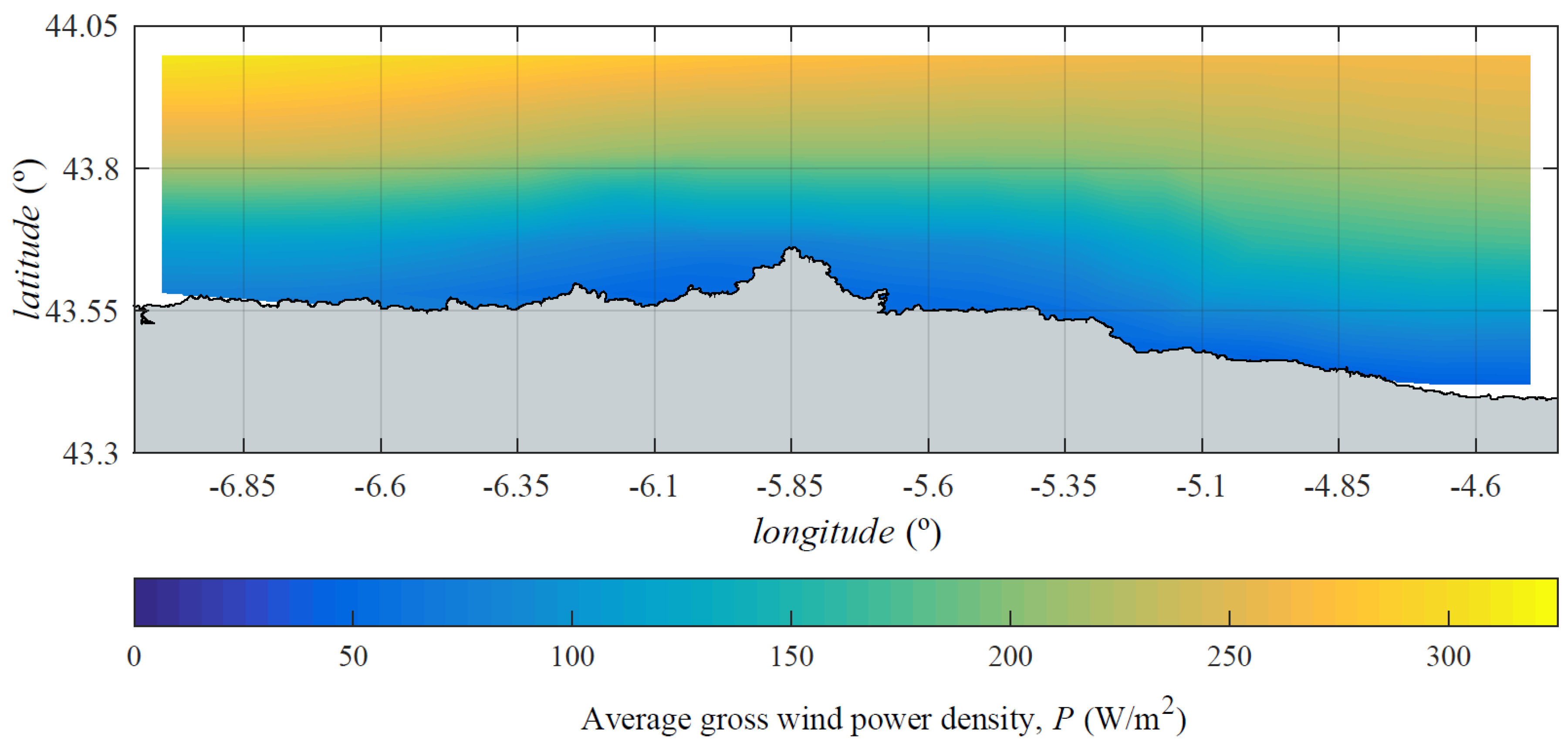Offshore Wind Energy Resource Atlas of Asturias (N Spain) †
Abstract
:1. Introduction
- the better quality of the resource (the wind speed is higher and more uniform in the sea); and
- the larger suitable free areas where offshore wind farms can be installed, which leads to larger installations and reduced environmental impacts in terms of noise emission and visual impact.
2. Material and Methods
3.1. Wind Datasets
3.2. Wind Profile
3.3. The Weibull Distributtion
3.4. Quantification of the Offshore Wind Resource
4. Results
Author Contributions
Acknowledgments
Conflicts of Interest
References
- Esteban, M.D.; Diez, J.J.; López, J.S.; Negro, V. Why offshore wind energy? Renew. Energy 2011, 36, 444–450. [Google Scholar] [CrossRef]
- Jung, C.; Schindler, D.; Laible, J. National and global wind resource assessment under six wind turbine installation scenarios. Energy Convers. Manag. 2018, 156, 403–415. [Google Scholar] [CrossRef]
- Veigas, M.; Carballo, R.; Iglesias, G. Wave and offshore wind energy on an island. Energy Sustain. Dev. 2014, 22, 57–65. [Google Scholar] [CrossRef]
- Arapogianni, A.; Genachte, A.B.; Ochagavia, R.M.; Vergara, J.P.; Castell, D.; Tsouroukdissian, A.R.; Ugarte, A. Deep Water: The Next Step for Offshore Wind Energy; European Wind Energy Association: Brussels, Belgium, 2013; Available online: http//www.ewea.org (accessed on 25 September 2018).
- Pacheco, A.; Gorbeña, E.; Sequeira, C.; Jerez, S. An evaluation of offshore wind power production by floatable systems: A case study from SW Portugal. Energy 2017, 131, 239–250. [Google Scholar] [CrossRef]
- Kim, H.C.; Kim, M.H.; Lee, J.Y.; Kim, E.S.; Zhang, Z. Global Performance Analysis of 5MW WindFloat and OC4 Semi-Submersible Floating Offshore Wind Turbines (FOWT) by Numerical Simulations. In Proceedings of the 27th International Ocean and Polar Engineering Conference 2017, San Francisco, CA, USA, 25–30 June 2017. [Google Scholar]
- Uppala, S.M.; Kållberg, P.W.; Simmons, A.J.; Andrae, U.; Bechtold, V.D.C.; Fiorino, M.; Li, X. The ERA-40 re-analysis. Q. J. R. Meteorol. Soc. 2005, 131, 2961–3012. [Google Scholar] [CrossRef]
- Cats, G.; Wolters, L. The Hirlam project. IEEE Comput. Sci. Eng. 1996, 3, 4–7. [Google Scholar] [CrossRef]
- Del Jesus, F.; Menéndez, M.; Guanche, R.; Losada, I.J. A wind chart to characterize potential offshore wind energy sites. Comput. Geosci. 2014, 71, 62–72. [Google Scholar] [CrossRef]



Publisher’s Note: MDPI stays neutral with regard to jurisdictional claims in published maps and institutional affiliations. |
© 2018 by the authors. Licensee MDPI, Basel, Switzerland. This article is an open access article distributed under the terms and conditions of the Creative Commons Attribution (CC BY) license (https://creativecommons.org/licenses/by/4.0/).
Share and Cite
López, M.; Rodríguez-Fuertes, N.; Carballo, R. Offshore Wind Energy Resource Atlas of Asturias (N Spain). Proceedings 2018, 2, 1416. https://doi.org/10.3390/proceedings2231416
López M, Rodríguez-Fuertes N, Carballo R. Offshore Wind Energy Resource Atlas of Asturias (N Spain). Proceedings. 2018; 2(23):1416. https://doi.org/10.3390/proceedings2231416
Chicago/Turabian StyleLópez, Mario, Noel Rodríguez-Fuertes, and Rodrigo Carballo. 2018. "Offshore Wind Energy Resource Atlas of Asturias (N Spain)" Proceedings 2, no. 23: 1416. https://doi.org/10.3390/proceedings2231416






